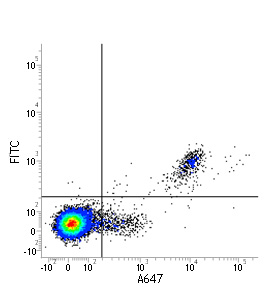CD20 Marker Antibodies

- On This Page
- Overview
- Anti-human CD20 clones
- Anti-mouse CD20 clones
- CD20 images by application
- CD20 antibodies
- References
Overview
CD20 is a 33 kDa cell surface glycosylated phosphoprotein and a member of the membrane spanning 4A gene family, being encoded by the MS4A1 gene (Tedder et al. 1988). Members of the membrane spanning family 4A share common structure characteristics and patterns of cellular expression. CD20 is also known as B-lymphocyte surface antigen B1, and Bp35 and is expressed on almost all B cells, except plasma cells. CD20 is also found to a lesser extent on some T cell subsets. It has been shown in both human and mouse that the level of CD20 expression increases with the stage of maturation of the B cell therefore showing differing amounts according to the B cell subset (Uchida et al. 2004). CD20 can be found in complexes with MHC class I, MHC II, CD53, CD81, CD82.
CD20 is important in the regulation of B cell activation and proliferation, and also in the regulation of intracellular calcium being directly involved in transmembrane calcium influx (Bubien et al. 1993). As CD20 is expressed on malignant B cells, it is consequently a target of several therapeutic agents involved in the treatment of B cell lymphomas and leukaemia.
Anti-human CD20 clones
- Clone 2H7 antibody (MCA1710) has been mapped to the sequence YNCEPANPSEKNSPST which lies in the large extracellular loop of human CD20. Applications for this antibody include; flow cytometry and immunohistochemistry – frozen
- The L26 clone antibody recognizes an epitope in the cytoplasmic domain and therefore requires permeabilization of the tissue for staining applications. Unlike many anti-CD20 antibodies that recognize the extracellular domain, the epitope recognized by L26 will not be blocked by therapeutic antibodies to CD20, like Rituximab. Recommended applications include immunohistochemistry – frozen, immunohistochemistry – paraffin sections, immunoprecipitation and western blotting
Anti-mouse CD20 clones
- Clone SA275A11, recommended for use in flow cytometry
- Clone QCH6A7 recognises the epitope in the extracellular domain, and is recommended for use in flow cytometry
- Clone AISB12 recognises the epitope in the extracellular loop domain, and is recommended for use in flow cytometry, functional assays and western blotting. Antibody staining is not as bright as that observed using clone QCH6A7
CD20 antibody images by application
CD20 Antibodies
| Description | Target | Format | Clone | Applications | Citations | Code |
|---|
Searching for your antibody of choice is made easy by the use of the sophisticated filter table, which allows you to select for specific antibody parameters. If you are unable to find your desired antibody simply contact us as we are adding new product all the time and we will be happy to help advise you.
References
- Bubien JK et al. (1993). Transfection of the CD20 cell surface molecule into ectopic cell types generates Ca2+ conductance found constitutively in B lymphocytes. J Cell Biol. 121, 1121-1132.
- Tedder TF et al. (1988). Isolation and structure of a cDNA encoding the B1 (CD20) cell-surface antigen of human B lymphocytes. Proc Natl Acad Sci USA. 85(1), 208-212.
- Uchida J et al. (2004). Mouse CD20 expression and function. Inter Immunol. 16(1), 119-129.






